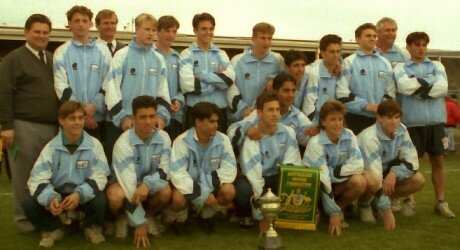The NSW under-15s won the 1994 national championships at Kim Reserve, Altona, with a team which included Harry Kewell and Brett Emerton (front row, far right), both destined to become Socceroos. Also in that side were Michael Cunico, later playing with the Young Socceroos, Northern Spirit and Sydney United; Sebastian Sinozic, then with St George who became a Young Socceroo; Yane Talcevski of Sydney Olympic; Robert Trajcevski of Wollongong Wolves; and Adam Brodbeck of the NSW Academy who played in the National Soccer League.
Is this as good as it gets?
By Roy Hay
The Socceroos came up just short in their quest to win the Asian Cup of Nations with a team which has been described as drawn from the golden age of Australian football. Having qualified for successive World Cups and now reached the final of a major tournament for the first time it is permissible to wonder if this is as good as it gets. It would, however, be a slight on the memory of Johnny Warren to accept such thoughts. Warren always said we should not be aiming to qualify for World Cups, we should set our sights on winning them.
It is true there have been other examples in the world game of golden generations which did not quite make it. Portugal had what was generally accepted as one of the most talented groups ever to play football in the 1990s including Luis Figo, Rui Costa and Joao Pinto. As under-20s they won two World Youth Cups, defeating the Young Socceroos in a pulsating semi-final, in 1991, but never managed to win a major senior tournament. Geelong’s Kris Trajanovski played in that match. The closest they got was the final of the European championship in 2004, which Portugal hosted, but lost to Greece by a single goal, just as the Socceroos did to Japan. Before the World Cup in South Africa last year there was talk of a golden generation of English players, but that did not survive the opening game.
There are sound reasons for believing that Australia can achieve more than it has so far in the world game and part of the evidence for this is what the Matildas have already done. Australia’s women’s team is already the champion of Asia and has qualified for the World Cup in Germany later this year. The handicaps faced by the women’s team are arguably greater than those facing the men, even if the number of countries taking part in international competitions and the general standard of play may be somewhat lower, though this is arguable. We now have a women’s national competition, though only seven teams are currently taking part. The short season means that some of our elite players can combine playing in top overseas leagues in Europe or the United States with the W-League at home. The development program for young players is beginning to produce the next generation of talented individuals who are taking part in youth internationals. Coach of the Matildas, Tom Sermanni, gave several young players a chance to take part in the Asian championship last year and was rewarded with victory.
Australian coaches of A-League teams and many observers agree that the standard of the national male competition has never been higher. Several of the coaches have been bringing in talented youngsters and many of them have made an immediate, and in some cases, a sustained impact already. A couple of them appeared for the Socceroos in Qatar including Melbourne Victory’s twenty-two year old striker Robbie Kruse. Geelong’s Matthew Spiranovic and Queenslander Tommy Oar did not see any game time but were important parts of the squad and will have benefitted immensely from the experience. In the domestic game the list of really talented younger players includes Matthew Ryan, Central Coast Mariners’ outstanding keeper at 18, Matthew Leckie, striker for Adelaide United, cruelled by injury but now hitting his straps again, Luke de Vere, defender extraordinaire for Brisbane Roar, Aziz Behich, perpetual motion on the left flank for Melbourne Heart, Ben Kantarovski at Newcastle Jets, who reminds many of Ned Zelic, and several more. Australian youth is recovering from the hiatus when the National Soccer League was closed down and it took two years before the A-League kicked off. Many youngsters had careers interrupted at a critical stage in their development and the impact has been felt in the recent past.
So, as a glass half-full person, I am enormously optimistic that the next generation of Olyroos and Socceroos will be even better than our much-lauded golden generation. I expect them to demonstrate this in the very near future given that coaches at national and international level allow them to do so.








Marnie Haig-Muir: Your review of the latest Rankin is right on the money, Roy. This book...